tow RENAULT TWINGO 2012 2.G Owner's Manual
[x] Cancel search | Manufacturer: RENAULT, Model Year: 2012, Model line: TWINGO, Model: RENAULT TWINGO 2012 2.GPages: 220, PDF Size: 6.73 MB
Page 149 of 220
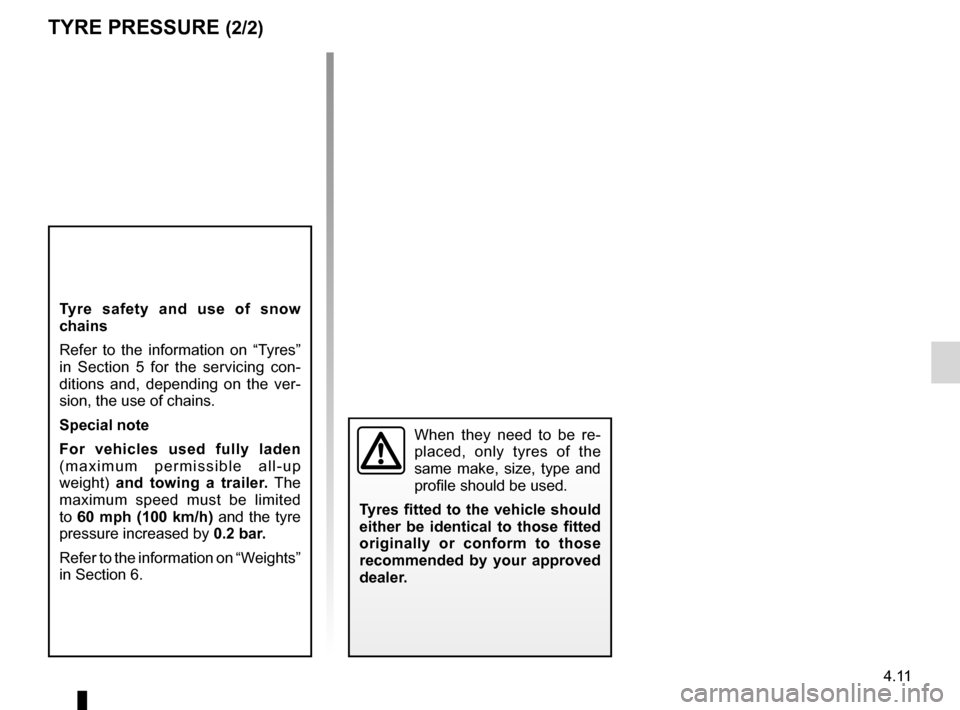
JauneNoirNoir texte
4.11
ENG_UD29222_2
Pression de gonflage des pneumatiques (X44 - Renault)
ENG_NU_952-4_X44_Renault_4
TyRE pRESSURE (2/2)
Tyre safety and use of snow
chains
Refer to the information on “Tyres”
in Section 5 for the servicing con -
ditions and, depending on the ver -
sion, the use of chains.
Special note
For vehicles used fully laden
( m a x i m u m p e r m i s s i b l e a l l - u p
weight) and towing a trailer. The
maximum speed must be limited
to 60 mph (100 km/h) and the tyre
pressure increased by 0.2 bar.
Refer to the information on “Weights”
in Section 6.
When they need to be re -
placed, only tyres of the
same make, size, type and
profile should be used.
Tyres fitted to the vehicle should
either be identical to those fitted
originally or conform to those
recommended by your approved
dealer.
Page 155 of 220
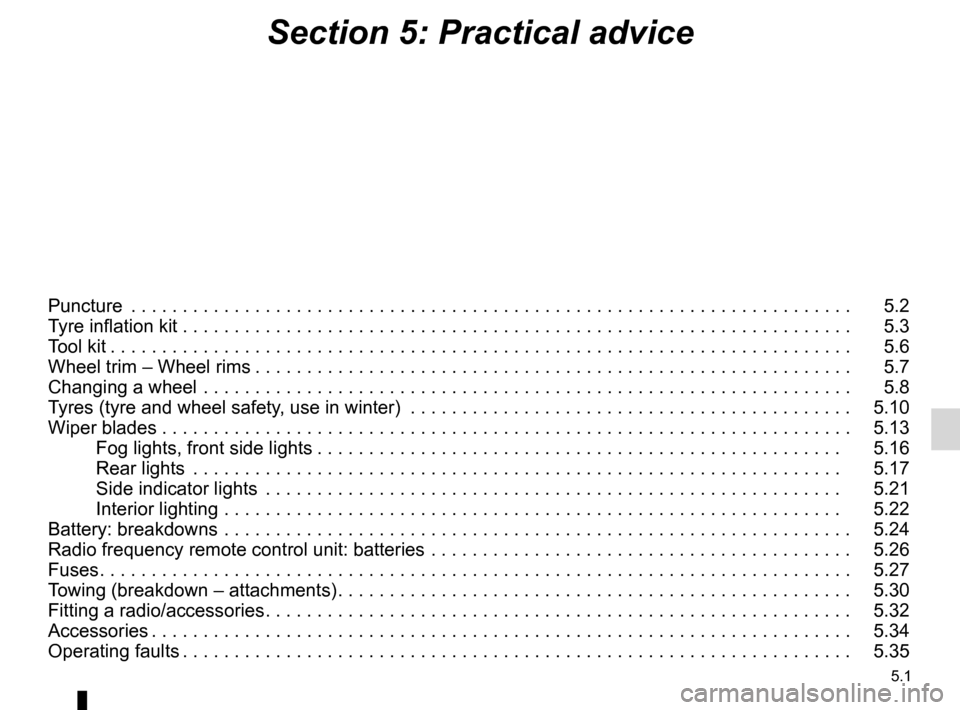
5.1
ENG_UD30797_17
Sommaire 5 (X44 - Renault)
ENG_NU_952-4_X44_Renault_5
Section 5: Practical advice
Puncture . . . . . . . . . . . . . . . . . . . . . . . . . . . . . . . . . . . . . . . . . . . . . . . . . . . . . . . . . . . . . . . . . . . . . . 5.2
Tyre inflation kit . . . . . . . . . . . . . . . . . . . . . . . . . . . . . . . . . . . . . . . . . . . . . . . . . . . . . . . . . . . . . . . . . 5.3
Tool kit . . . . . . . . . . . . . . . . . . . . . . . . . . . . . . . . . . . . . . . . . . . . . . . . . . . . . . . . . . . . . . . . . . . . . . . . 5.6
Wheel trim – Wheel rims . . . . . . . . . . . . . . . . . . . . . . . . . . . . . . . . . . . . . . . . . . . . . . . . . . . . . . . . . . 5.7
Changing a wheel . . . . . . . . . . . . . . . . . . . . . . . . . . . . . . . . . . . . . . . . . . . . . . . . . . . . . . . . . . . . . . . 5.8
Tyres (tyre and wheel safety, use in winter) . . . . . . . . . . . . . . . . . . . . . . . . . . . . . . . . . . . . . . . . . . . 5.10
Wiper blades . . . . . . . . . . . . . . . . . . . . . . . . . . . . . . . . . . . . . . . . . . . . . . . . . . . . . . . . . . . . . . . . . . . 5.13
Fog lights, front side lights . . . . . . . . . . . . . . . . . . . . . . . . . . . . . . . . . . . . . . . . . . . . . . . . . . . 5.16
Rear lights . . . . . . . . . . . . . . . . . . . . . . . . . . . . . . . . . . . . . . . . . . . . . . . . . . . . . . . . . . . . . . . 5.17
Side indicator lights . . . . . . . . . . . . . . . . . . . . . . . . . . . . . . . . . . . . . . . . . . . . . . . . . . . . . . . . 5.21
Interior lighting . . . . . . . . . . . . . . . . . . . . . . . . . . . . . . . . . . . . . . . . . . . . . . . . . . . . . . . . . . . . 5.22
Battery: breakdowns . . . . . . . . . . . . . . . . . . . . . . . . . . . . . . . . . . . . . . . . . . . . . . . . . . . . . . . . . . . . . 5.24
Radio frequency remote control unit: batteries . . . . . . . . . . . . . . . . . . . . . . . . . . . . . . . . . . . . . . . . . 5.26
Fuses . . . . . . . . . . . . . . . . . . . . . . . . . . . . . . . . . . . . . . . . . . . . . . . . . . . . . . . . . . . . . . . . . . . . . . . . . 5.27
Towing (breakdown – attachments) . . . . . . . . . . . . . . . . . . . . . . . . . . . . . . . . . . . . . . . . . . . . . . . . . . 5.30
Fitting a radio/accessories . . . . . . . . . . . . . . . . . . . . . . . . . . . . . . . . . . . . . . . . . . . . . . . . . . . . . . . . . 5.32
Accessories . . . . . . . . . . . . . . . . . . . . . . . . . . . . . . . . . . . . . . . . . . . . . . . . . . . . . . . . . . . . . . . . . . . . 5.34
Operating faults . . . . . . . . . . . . . . . . . . . . . . . . . . . . . . . . . . . . . . . . . . . . . . . . . . . . . . . . . . . . . . . . . 5.35
Page 160 of 220
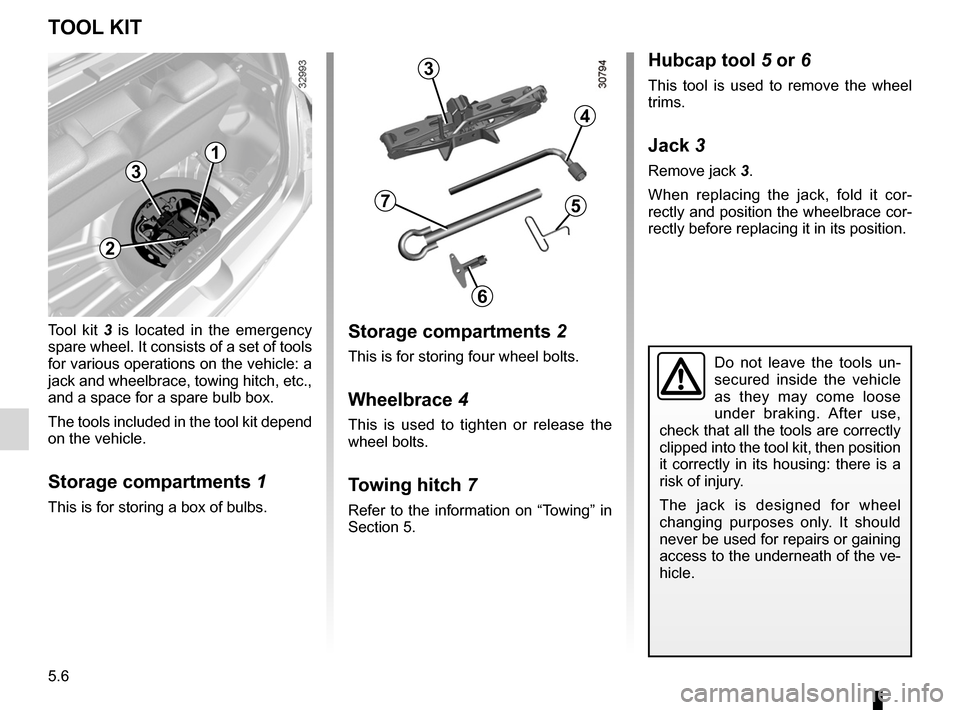
hubcap tool ............................................................ (current page)
wheelbrace ............................................................ (current page)
emergency spare wheel ........................................ (current page)
towing hitch ............................................................ (current page)
5.6
ENG_UD24733_5
Bloc outils (X44 - Renault)
ENG_NU_952-4_X44_Renault_5
Tool kit
Tool kit 3 is located in the emergency
spare wheel. It consists of a set of tools
for various operations on the vehicle: a
jack and wheelbrace, towing hitch, etc.,
and a space for a spare bulb box.
The tools included in the tool kit depend
on the vehicle.
Storage compartments 1
This is for storing a box of bulbs.
Storage compartments 2
This is for storing four wheel bolts.
Wheelbrace 4
This is used to tighten or release the
wheel bolts.
t owing hitch 7
Refer to the information on “Towing” in
Section 5.
Hubcap tool 5 or 6
This tool is used to remove the wheel
trims.
Jack 3
Remove jack 3.
When replacing the jack, fold it cor -
rectly and position the wheelbrace cor-
rectly before replacing it in its position.
Do not leave the tools un -
secured inside the vehicle
as they may come loose
under braking. After use,
check that all the tools are correctly
clipped into the tool kit, then position
it correctly in its housing: there is a
risk of injury.
The jack is designed for wheel
changing purposes only. It should
never be used for repairs or gaining
access to the underneath of the ve-
hicle.
t OOL KIt
1
3
2
3
4
5
6
7
Page 178 of 220
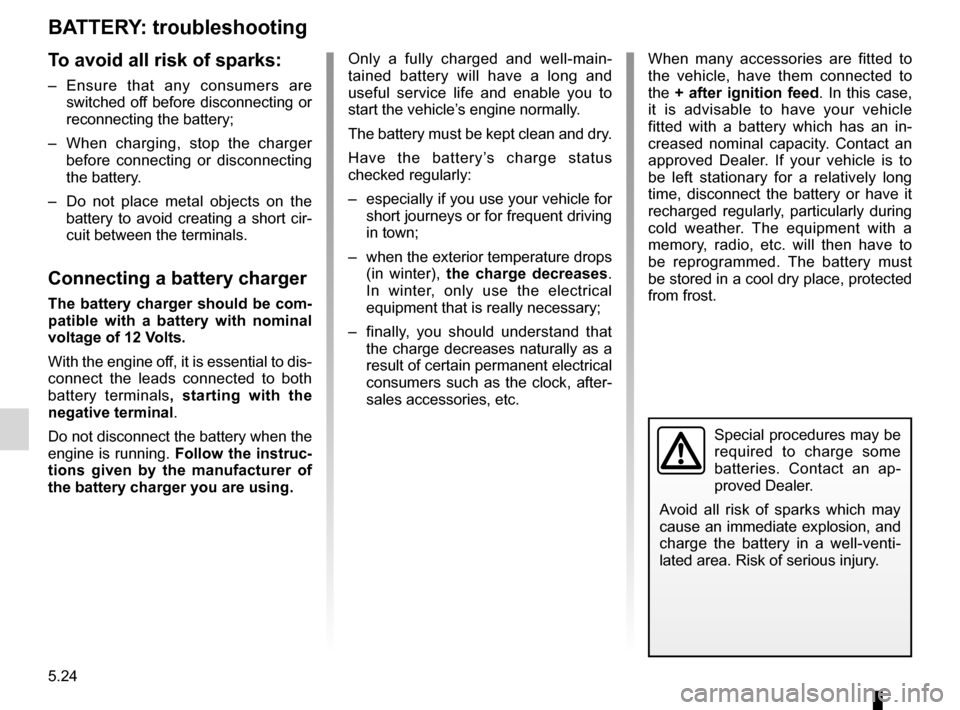
batterytroubleshooting ............................... (up to the end of the DU)
5.24
ENG_UD24705_3
Batterie : dépannage (X44 - Renault)
ENG_NU_952-4_X44_Renault_5
Jaune NoirNoir texte
Battery: troubleshooting
BAtter Y: troubleshooting
to avoid all risk of sparks:
– Ensure that any consumers are
switched off before disconnecting or
reconnecting the battery;
– When charging, stop the charger
before connecting or disconnecting
the battery.
– Do not place metal objects on the
battery to avoid creating a short cir-
cuit between the terminals.
connecting a battery charger
the battery charger should be com-
patible with a battery with nominal
voltage of 12 Volts.
With the engine off, it is essential to dis-
connect the leads connected to both
battery terminals , starting with the
negative terminal.
Do not disconnect the battery when the
engine is running. Follow the instruc-
tions given by the manufacturer of
the battery charger you are using. Only a fully charged and well
-main -
tained battery will have a long and
useful service life and enable you to
start the vehicle’s engine normally.
The battery must be kept clean and dry.
Have the battery’s charge status
checked regularly:
– especially if you use your vehicle for
short journeys or for frequent driving
in town;
– when the exterior temperature drops
(in winter), the charge decreases .
In winter, only use the electrical
equipment that is really necessary;
– finally, you should understand that
the charge decreases naturally as a
result of certain permanent electrical
consumers such as the clock, after-
sales accessories, etc.
When many accessories are fitted to
the vehicle, have them connected to
the + after ignition feed. In this case,
it is advisable to have your vehicle
fitted with a battery which has an in -
creased nominal capacity. Contact an
approved Dealer. If your vehicle is to
be left stationary for a relatively long
time, disconnect the battery or have it
recharged regularly, particularly during
cold weather. The equipment with a
memory, radio, etc. will then have to
be reprogrammed. The battery must
be stored in a cool dry place, protected
from frost.
Special procedures may be
required to charge some
batteries. Contact an ap -
proved Dealer.
Avoid all risk of sparks which may
cause an immediate explosion, and
charge the battery in a well-venti -
lated area. Risk of serious injury.
Page 184 of 220
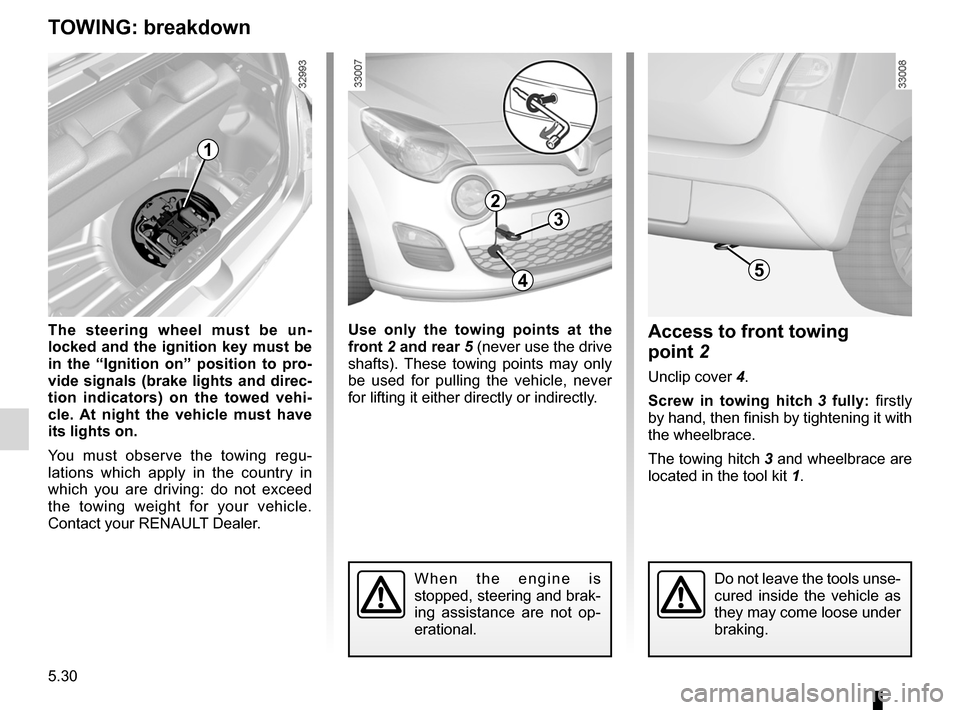
towingbreakdown ...................................... (up to the end of the DU)
towing towing equipment ............................ (up to the end of the DU)
towing hitch ........................................... (up to the end of the DU)
towing a caravan .................................. (up to the end of the DU)
5.30
ENG_UD24739_3
Remorquage : dépannage (X44 - Renault)
ENG_NU_952-4_X44_Renault_5
Jaune NoirNoir texte
Towing (breakdown – attachments)
tOWIng: breakdown
the steering wheel must be un -
locked and the ignition key must be
in the “Ignition on” position to pro -
vide signals (brake lights and direc-
tion indicators) on the towed vehi -
cle. At night the vehicle must have
its lights on.
You must observe the towing regu -
lations which apply in the country in
which you are driving: do not exceed
the towing weight for your vehicle.
Contact your RENAULT Dealer. u
se only the towing points at the
front 2 and rear 5 (never use the drive
shafts). These towing points may only
be used for pulling the vehicle, never
for lifting it either directly or indirectly.Access to front towing
point 2
Unclip cover 4.
Screw in towing hitch 3 fully: firstly
by hand, then finish by tightening it with
the wheelbrace.
The towing hitch 3 and wheelbrace are
located in the tool kit 1.
W h e n t h e e n g i n e i s
stopped, steering and brak-
ing assistance are not op -
erational.
1
Do not leave the tools unse-
cured inside the vehicle as
they may come loose under
braking.
3
2
45
Page 185 of 220
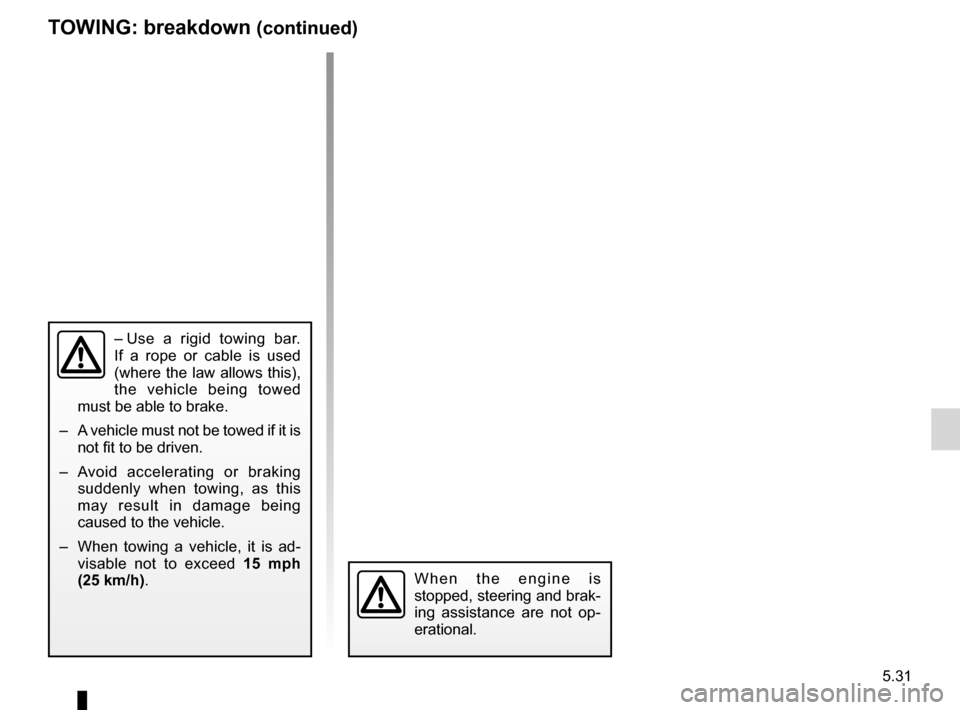
JauneNoirNoir texte
5.31
ENG_UD24739_3
Remorquage : dépannage (X44 - Renault)
ENG_NU_952-4_X44_Renault_5
t OWIng: breakdown (continued)
W h e n t h e e n g i n e i s
stopped, steering and brak-
ing assistance are not op -
erational.
– Use a rigid towing bar.
If a rope or cable is used
(where the law allows this),
the vehicle being towed
must be able to brake.
– A vehicle must not be towed if it is
not fit to be driven.
– Avoid accelerating or braking
suddenly when towing, as this
may result in damage being
caused to the vehicle.
– When towing a vehicle, it is ad -
visable not to exceed 15 mph
(25 km/h).
Page 200 of 220
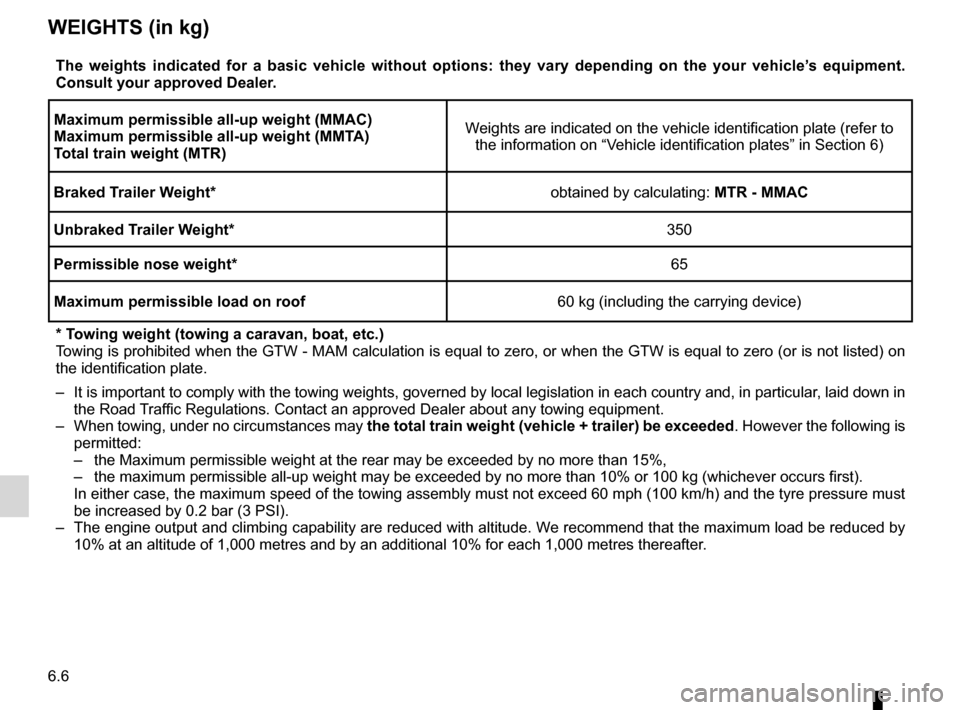
weights .................................................................. (current page)
towing weights ....................................................... (current page)
towing a caravan .................................. (up to the end of the DU)
towing ................................................... (up to the end of the DU)
technical specifications ......................... (up to the end of the DU)
6.6
ENG_UD26871_6
Masses (en kg) NU 773-1 (X44 - Renault)
ENG_NU_952-4_X44_Renault_6
Weights
WEIGHTS (in kg)
The weights indicated for a basic vehicle without options: they vary depending on the your vehicle’s equipment.
Consult your approved Dealer.
Maximum permissible all-up weight (MMAC)
Maximum permissible all-up weight (MMTA)
Total train weight (MTR) Weights are indicated on the vehicle identification plate (refer to
the information on “Vehicle identification plates” in Section 6)
Braked Trailer Weight* obtained by calculating: MTR - MMAC
Unbraked Trailer Weight* 350
Permissible nose weight* 65
Maximum permissible load on roof 60 kg (including the carrying device)
* Towing weight (towing a caravan, boat, etc.)
Towing is prohibited when the GTW - MAM calculation is equal to zero, or when the GTW is equal to zero (or is not listed) on
the identification plate.
– It is important to comply with the towing weights, governed by local legislation in each country and, in particular, laid down in
the Road Traffic Regulations. Contact an approved Dealer about any towing equipment.
– When towing, under no circumstances may the total train weight (vehicle + trailer) be exceeded . However the following is
permitted:
– the Maximum permissible weight at the rear may be exceeded by no more than 15%,
– the maximum permissible all-up weight may be exceeded by no more than 10% or 100 kg (whichever occurs first).
In either case, the maximum speed of the towing assembly must not exceed 60 mph (100 km/h) and the tyre pressure must
be increased by 0.2 bar (3 PSI).
– The engine output and climbing capability are reduced with altitude. We recommend that the maximum load be reduced by
10% at an altitude of 1,000 metres and by an additional 10% for each 1,000 metres thereafter .
Page 216 of 220

7.4
FRA_UD30806_17
Index (X44 - Renault)
ENG_NU_952-4_X44_Renault_7
Jaune NoirNoir texte
AlphAbeticAl index (4/5)
rear seats ........................................................................... 3.31
functions ...................................................................... 3.31
rear view mirrors ................................................................ 1.54
remote control door locking unit ................................1.2 → 1.4
remote control electric door locking batteries ....................................................................... 5.26
RENAULT ANTI-INTRUDER DEVICE (RAID) ...................1.10
replacement parts ................................................................ 6.7
reverse gear selecting ......................................................................... 2.6
roof bars ............................................................................ 3.39
roof rack roof bars ....................................................................... 3.39
running in ............................................................................. 2.2
S
screen wash/wipe ................................................... 1.62 – 1.63
seat belt pretensioners .......................................... 1.19 → 1.24
seat belts ............................................................... 1.15 → 1.18
seats adjustment .................................... 1.12 – 1.14, 3.29 – 3.30
service sheets .......................................................... 6.8 → 6.13
side indicator lights changing bulbs ............................................................. 5.21
side protection devices ...................................................... 1.24
signals and lights ................................................... 1.58 → 1.60
speakers location ............................................................. 5.32 – 5.33
special features of diesel versions .......................................2.5
special features of petrol vehicles ....................................... 2.4
speed limiter .......................................................... 2.15 → 2.17
starting the engine ...................................................... 2.2 – 2.3
steering wheel adjustment ................................................................... 1.55
stopping the engine ............................................................. 2.3
storage compartment ............................................. 3.25 → 3.27storage compartments
........................................... 3.25 → 3.27
sun visor ............................................................................ 3.22
sunroof .................................................................... 3.23 – 3.24
t
tailgate ................................................................... 3.33 → 3.35
tanks and reservoirs: windscreen washer ........................................................ 4.9
technical specifications ............................... 6.2 – 6.3, 6.6 – 6.7
telephone ........................................................................... 3.40
temperature regulation ............................................ 3.7 → 3.17
towing .................................................................................. 6.6
breakdown ........................................................ 5.30 – 5.31
towing equipment ..................................... 3.38, 5.30 – 5.31
towing a caravan ............................................. 5.30 – 5.31, 6.6
towing hitch ...................................................... 5.6, 5.30 – 5.31
towing rings ....................................................................... 3.37
towing weights ..................................................................... 6.6
traction control: ASR .............................................. 2.12 → 2.14
transporting children .......................... 1.26 – 1.27, 1.29 → 1.35
transporting objects in the luggage compartment ........................................ 3.37
trims ..................................................................................... 5.7
trip computer and warning system .........................1.49 → 1.53
tyre inflation kit ........................................................... 5.3 → 5.5
tyre pressure ........................................................... 4.10 – 4.11
tyre pressures ......................................................... 4.10 – 4.11
tyres .......................................... 2.10, 4.10 – 4.11, 5.10 → 5.12
U
use in winter ...................................................................... 5.12
V
vehicle identification ................................................... 6.2 – 6.3
vehicle identification plates ......................................... 6.2 – 6.3
ventilation ................................................................ 3.4 → 3.18